DPSIR Model Applied to the Remediation of Contaminated Sites. A Case Study: Mar Piccolo of Taranto
Abstract
:1. Introduction
2. DPSIR Framework of the Study
3. Case Study General Framing
4. Driving Forces
4.1. Demography
4.2. Agriculture
4.3. Industry
4.4. Landfills and Waste Treatment Plants
5. Pressures
5.1. Discharges of Nutrients and Contaminants
5.2. Pollution in Groundwater
5.3. Air Pollution
6. States
6.1. Marine Sediment Characterization
- Granulometry, water content, specific weight, pH, redox potential, metals and trace elements (Al, As, Cd, total Cr, Fe, Hg, Ni, Pb, Cu, Zm, V), polychlorinated biphenyls, organochlorine pesticides, PAHs, light hydrocarbons C ≤ 12, heavy hydrocarbons C > 12, total nitrogen, total phosphorus, cyanides, and total organic carbon (TOC) on 1023 samples;
- Organotin compounds on 106 samples;
- Aromatic solvents (BTEX), phenols on 112 samples;
- Sb, Cr VI, Se and St on 138 samples;
- Microbiological parameters (fecal streptococci, salmonella, sopite-reducing spores:) on 128 samples;
- Dioxins and furans and asbestos on 23 samples;
- Ecotoxicological tests (Vibrio fischeri e Brachionus plicatilis) on 20 samples.
6.2. Sea Water Characterization
| Source | (μg/L) | (ng/L) | Outflow (Annual Average) [51] (m3/s) | |||||||
|---|---|---|---|---|---|---|---|---|---|---|
| Cd | Cu | Ni | Pb | Hg | Mn | Fe | Zn | PCBtot | ||
| Citro Galeso | 0.007 | 0.753 | 0.293 | 0.041 | 0.011 | 0.031 | 9.515 | 3.74 | 0.2 | 0.75 |
| Citro Citrello | 0.011 | 1.042 | 0.242 | 0.156 | 0.009 | 0.027 | 10.616 | 0.772 | 1.84 | 0.35 |
| Citro Lecopre | 0.008 | 0.701 | 0.036 | 0.131 | 0.005 | 0.016 | 8.39 | 0.483 | 0.21 | 0.65 |
| Station 2 | 0.043 | 1.958 | 0.831 | 0.248 | - | 1.97 | 39.39 | 6.73 | 1.08 | - |
| Galeso river | 0.003 | 0.218 | 0.043 | 0.055 | 0.002 | - | - | - | 0.06 | - |
| Citrello channel | 0.002 | 0.395 | 0.039 | 0.043 | 0.002 | - | - | - | 0.36 | - |
| Battendieri spring | 0.003 | 0.217 | 0.073 | 0.067 | 0.004 | - | - | - | - | - |
| “AIVAM” spring | 0.004 | 0.07 | 0.039 | 0.045 | 0.003 | - | - | - | 0.06 | - |
6.3. Biodiversity
6.4. Anthropization of Sea Bottom
- Long-line mussel farm (44.10 ha area) with the use of buoys and ropes, as shown in Figure 12c;
- Pole mussel farm with (42.45 ha area) with the use of three wooden or metallic poles driven into the seabed;
- Mussel frame structures-based farm (10.69 ha area), with a metallic net made up of poles and ropes to contain boxes of fishermen;
- Traces of anchorage (24.87 ha area) mainly related to mussel farming and military activities.
6.5. Marine Litter
7. Impacts
7.1. Contaminants Mobility
7.2. Effects of Contaminants in Marine Organisms
7.3. Human Health
7.4. Eutrophication of Toxic Algae
7.5. Dewatering Pump
8. Responses
8.1. Political Approach
- Planning all the complex remediation strategies of all the sites with clear reachable objectives and times of approval, and the realization of interventions;
- Developing infrastructural interventions complementary to remediation actions;
- Identifying measures designed to increase the level of employment;
- Identifying incentives for local companies interested in adopting innovative environmental technologies;
- Identifying incentives for new investments, even for industrial requalification of the area;
- Carrying out and completing studies about environment and health connected to the presence of industrial plants in order to identify and realize measures of mitigation, reduction, and prevention.
- Remediation of the Mar Piccolo shores;
- Sustainable removal and disposal of anthropic materials on the sea bottom;
- Cleanup of unexploded ordinance and other explosive remnants;
- Mitigation actions to impacts derived from wastewater discharges;
- Intervention on abatement of contamination sources;
- Remediation plan and/or permanent safety measures for contaminated sediments;
- Protection, monitoring, and translocation of species of conservation interest;
- Removal of the floating fish farm.
8.2. Remediation Technologies
9. Discussion
10. Conclusions
Supplementary Materials
Author Contributions
Funding
Acknowledgments
Conflicts of Interest
References
- Labianca, C.; De Gisi, S.; Notarnicola, M. Assessing the correlation between contamination sources and environmental quality of marine sediments using multivariate analysis. Environ. Eng. Manag. J. 2018, 17, 10. [Google Scholar] [CrossRef]
- Gabellini, M.; Ausili, A.; Romano, E.; Geraldini, S.; Tornato, A.; Dastoli, S. Contaminated Sediments in Italy, State of the Art, Management and Remediation. REMTECH Ferrara. Available online: https://clu-in.org/slovenia/download/Sediment_Remediation/Mariotti.pdf (accessed on 25 March 2020).
- Lans Bovenberg, A.; Smulders, S. Environmental quality and pollution-augmenting technological change in a two-sector endogenous growth model. J. Public Econ. 1995, 57, 369–391. [Google Scholar] [CrossRef] [Green Version]
- Neris, J.B.; Olivares, D.M.M.; Velasco, F.G.; Luzardo, F.H.M.; Correia, L.O.; González, L.N. HHRISK: A code for assessment of human health risk due to environmental chemical pollution. Ecotoxicol. Environ. Saf. 2019, 170, 538–547. [Google Scholar] [CrossRef]
- El Hattab, M.H.; Theodoropoulos, G.; Rong, X.; Mijic, A. Applying the Systems Approach to Decompose the SuDS Decision-Making Process for Appropriate Hydrologic Model Selection. Water 2020, 12, 632. [Google Scholar] [CrossRef] [Green Version]
- Ash, M.; Fetter, T.R. Who Lives on the Wrong Side of the Environmental Tracks? Evidence from the EPA’s Risk-Screening Environmental Indicators Model. Soc. Sci. Q. 2004, 85, 441–462. [Google Scholar] [CrossRef] [Green Version]
- Keller, V.D.J.; Whelan, M.J.; Rees, H.G. A Global Assessment of Chemical Effluent Dilution Capacities from a Macro-Scale Hydrological Model; IAHS Publicatins: Wallingford, UK, 2006; Volume 308, p. 586. [Google Scholar]
- Borja, A.; Galparsoro, I.; Solaun, O.; Muxika, I.; Tello, E.M.; Uriarte, A.; Valencia, V. The European Water Framework Directive and the DPSIR, a methodological approach to assess the risk of failing to achieve good ecological status. Estuar. Coast. Shelf Sci. 2006, 66, 84–96. [Google Scholar] [CrossRef]
- European Commission. Guidance Document n. 3—Analysis of Pressures and Impacts. In Common Implementation Strategy for the Water Framework Directive (2000/60/EC); European Commission: Brussels, Belgium, 2003. [Google Scholar]
- Kristensen, P. The DPSIR Framework Background. In 27–29 September 2004 Workshop on a Comprehensive Detailed Assessment of the Vulnerability of Water Resources to Environmental Change in Africa Using River Basin Approach; UNEP Headquarters: Nairobi, Kenya, 2004. [Google Scholar]
- Lofrano, G.; Libralato, G.; Acanfora, F.G.; Pucci, L.; Carotenuto, M. Which lesson can be learnt from a historical contamination analysis of the most polluted river in Europe? Sci. Total Environ. 2015, 524, 246–259. [Google Scholar] [CrossRef]
- Caeiro, S.; Mourão, I.; Costa, M.H.; Painho, M.; Ramos, T.B.; Sousa, S. Application of the DPSIR Model to the Sado Estuary in a GIS Context-Social and Economical Pressures. In Proceedings of the 7th Conference on Geographic Information Science, Heraklion, Greece, 9 April–1 May 2004; Crete University Press: Crete, Greece; pp. 391–402. [Google Scholar]
- Huang, H.F.; Kuo, J.; Lo, S.L. Review of PSR framework and development of a DPSIR model to assess greenhouse effect in Taiwan. Environ. Monit. Assess. 2011, 177, 623–635. [Google Scholar] [CrossRef]
- Lin, T.; Xue, X.Z.; Lu, C.Y. Analysis of coastal wetland changes using the DPSIR model: A case study in Xiamen, China. Coast. Manag. 2007, 35, 289–303. [Google Scholar] [CrossRef]
- Jago-on, K.A.B.; Kaneko, S.; Fujikura, R.; Fujiwara, A.; Imai, T.; Matsumoto, T.; Zhang, J.; Tanikawa, H.; Tanaka, K.; Lee, B.; et al. Urbanization and subsurface environmental issues: An attempt at DPSIR model application in Asian cities. Sci. Total Environ. 2009, 407, 3089–3104. [Google Scholar] [CrossRef]
- Akbari, M.; Memarian, H.; Neamatollahi, E.; Jafari Shalamzari, M.; Alizadeh Noughani, M.; Zakeri, D. Prioritizing policies and strategies for desertification risk management using MCDM–DPSIR approach in northeastern Iran. Environ. Dev. Sustain. 2020, 1–21. [Google Scholar] [CrossRef]
- Lewison, R.L.; Rudd, M.A.; Al-Hayek, W.; Baldwin, C.; Beger, M.; Lieske, S.N.; Jones, C.; Satumanatpan, S.; Junchompoo, C.; Hines, E. How the DPSIR framework can be used for structuring problems and facilitating empirical research in coastal systems. Environ. Sci. Policy 2016, 56, 110–119. [Google Scholar] [CrossRef] [Green Version]
- National Law n. 426, Nuovi interventi in campo ambientale. Gazzetta Ufficiale Della Repubblica Italiana Del 14 Dicembre 1998. Available online: http://www.parlamento.it/parlam/leggi/98426l.htm (accessed on 25 March 2020).
- Scroccaro, I.; Matarrese, R.; Umgiesser, G. Application of a finite element model to the Taranto Sea. Chem. Ecol. 2004, 20, 205–224. [Google Scholar] [CrossRef]
- ISTAT Data. Statistiche Demografiche Taranto (TA)-Grafici su dati ISTAT. Available online: https://www.tuttitalia.it/puglia/64-taranto/statistiche/ (accessed on 25 March 2020).
- Brevé, M.A.; Skaggs, R.W. Hydrologic and Water Quality Impacts of Agricultural Drainage. Crit. Rev. Environ. Sci. Technol. 1994, 24, 1–32. [Google Scholar] [CrossRef]
- ISTAT Data. Fitosanitari. Available online: http://dati.istat.it/Index.aspx?DataSetCode=DCSP_FITOSANITARI (accessed on 25 March 2020).
- Gariazzo, C.; Papaleo, V.; Pelliccioni, A.; Calori, G.; Radice, P.; Tinarelli, G. Application of a Lagrangian particle model to assess the impact of harbour, industrial and urban activities on air quality in the Taranto area, Italy. Atmos. Environ. 2007, 41, 6432–6444. [Google Scholar] [CrossRef]
- Bellucci, L.G.; Cassin, D.; Giuliani, S.; Botter, M.; Zonta, R. Sediment pollution and dynamic in the Mar Piccolo of Taranto (southern Italy): Insights from bottom sediment traps and surficial sediments. Environ. Sci. Pollut. Res. 2016, 23, 12554–12565. [Google Scholar] [CrossRef]
- Bortone, I.; Labianca, C.; Todaro, F.; De Gisi, S.; Coulon, F.; Notarnicola, M. Experimental investigations and numerical modelling of in-situ reactive caps for PAH contaminated marine sediments. J. Hazard. Mater. 2020, 387, 121724. [Google Scholar] [CrossRef]
- Bevilacqua, M.; Braglia, M. Environmental efficiency analysis for ENI oil refineries. J. Clean. Prod. 2002, 10, 85–92. [Google Scholar] [CrossRef]
- Notarnicola, B.; Tassielli, G.; Renzulli, P.A. Industrial symbiosis in the Taranto industrial district: Current level, constraints and potential new synergies. J. Clean. Prod. 2016, 122, 133–143. [Google Scholar] [CrossRef]
- Cardellicchio, N.; Buccolieri, A.; Giandomenico, S.; Lopez, L.; Pizzulli, F.; Spada, L. Organic pollutants (PAHs, PCBs) in sediments from the Mar Piccolo in Taranto (Ionian Sea, Southern Italy). Mar. Pollut. Bull. 2007, 55, 451–458. [Google Scholar] [CrossRef]
- Piano di Gestione Dei Rifiuti Speciali Nella Regione Puglia. DGR N. 2668 of 28.12.2009 e DGR N. 819 of 23.04.2015. 2015. Available online: http://www.arpa.puglia.it/c/journal/view_article_content?groupId=13879&articleId=84072&version=1.1&resultGroupId=13879 (accessed on 27 March 2020).
- De Gisi, S.; Chiarelli, A.; Tagliente, L.; Notarnicola, M. Energy, environmental and operation aspects of a SRF-fired fluidized bed waste-to-energy plant. Waste Manag. 2018, 73, 271–286. [Google Scholar] [CrossRef] [PubMed]
- Il Mar Piccolo di Taranto Approfondimento Tecnico-Scientifico Sulle Interazioni Tra il Sistema Ambientale ed i Flussi di Contaminanti da Fonti Primarie e Secondarie Elaborazione di un Modello Concettuale Sito-Specifico (Conceptual Site Model). 2014. Available online: https://www.researchgate.net/publication/283716639_Approfondimento_tecnico-scientifico_sulle_interazioni_tra_il_sistema_ambientale_ed_i_flussi_di_contaminanti_da_fonti_primarie_e_secondarie_nel_Mar_Piccolo_di_Taranto (accessed on 29 March 2020).
- Cardellicchio, C.; Annicchiarico, N.; Leone, G.; Marra, C.; Paterno, P.; Piraino, S.; Ragone, P. I mari di Taranto: Problematiche di impatto ambientale. Atti Della Soc. Ital. Di Ecol. 1991, 12, 769–775. [Google Scholar]
- Caroppo, C.; Cardellicchio, N. Preliminary study on phytoplankton communities of Mar Piccolo in Taranto (Jonian Sea). Oebalia 1995, 21, 61–76. Available online: https://www.osti.gov/etdeweb/biblio/647267 (accessed on 25 March 2020).
- ARPA Puglia. Relazione sui dati ambientali dell’area di Taranto. 2009. Available online: http://www.arpa.puglia.it/web/guest/rapporti (accessed on 25 March 2020).
- De Filippis, G.; Foglia, L.; Giudici, M.; Mehl, S.; Margiotta, S.; Negri, S.L. Effects of different boundary conditions on the simulation of groundwater flow in a multi-layered coastal aquifer system (Taranto Gulf, southern Italy). Hydrogeol. J. 2017, 25, 2123–2138. [Google Scholar] [CrossRef]
- ARPA Puglia. Relazione Sui Dati Della Qualita’ Dell’Aria–Taranto. 2013; Available online: https://www.google.com.hk/url?sa=t&rct=j&q=&esrc=s&source=web&cd=&ved=2ahUKEwjokvvX3-LqAhUGdCsKHTVoCPoQFjAAegQIAxAB&url=http%3A%2F%2Fwww.arpa.puglia.it%2Fc%2Fdocument_library%2Fget_file%3Fuuid%3D176e8b33-e62b-41ad-a528-55828653f16e%26groupId%3D13883&usg=AOvVaw0Pq0PHv8lqF5ZqKdxrQcB- (accessed on 29 March 2020).
- Martinelli, D.; Mincuzzi, A.; Minerba, S.; Tafuri, S.; Conversano, M.; Caputi, G.; Lopalco, P.L.; Quarto, M.; Germinario, C.; Prato, R. Malignant cancer mortality in Province of Taranto (Italy). Geographic analysis in an area of high environmental risk. J. Prev. Med. Hyg. 2009, 50, 181–190. [Google Scholar]
- Trizio, L.; Angiuli, L.; Menegotto, M.; Fedele, F.; Giua, R.; Mazzone, F.; Carducci, A.G.C.; Bellotti, R.; Assennato, G. Effect of the Apulia air quality plan on PM10 and benzo (a) pyrene exceedances. Glob. J. Environ. Sci. Manag. 2016, 95–104. [Google Scholar] [CrossRef]
- Apulia Region. Piano Contenente Le Prime Misure di Intervento Per Il Risanamento Della Qualità Dell’aria Nel Quartiere Tamburi (Ta) Per Gli Inquinanti PM10 e Benzo(a)Pirene Ai Sensi Del D.lgs.155/2010 Art. 2012. Available online: http://www.comune.taranto.it/index.php/elenco-aree-tematiche/ambiente-e-territorio/piano-regionale-per-il-risanamento-della-qualita-dell-aria-nel-quartiere-tamburi-ta-pm10-e-b-a-p (accessed on 7 April 2020).
- Angiuli, L.; Trizio, L.; Giua, R.; Assennato, G. The Wind Days Protocol: The Impact of Mitigation Policies on PM and BaP Concentrations in the Industrial City of Taranto; Environmental Agency of Apulia Region: Apulia Region, Italy, 2014; pp. 4–5. [Google Scholar]
- ARPA Puglia Centro Regionale Aria. Rapporto Sui Livelli di Benzo(a)pirene e Metalli Pesanti Nel PM10 in Puglia Anno 2014. 2014. Available online: https://www.arpa.puglia.it/web/guest/metalli_bap (accessed on 7 April 2020).
- ISPRA. Elaborazione e Valutazione Dei Risultati Della Caratterizzazione Ai Fini Della Individuazione Degli Opportuni Interventi di Messa in Sicurezza e Bonifica del Sito di Interesse Nazionale di Taranto-Mar Grande II Lotto e Mar Piccolo. 2010. Available online: https://www.google.com.hk/url?sa=t&rct=j&q=&esrc=s&source=web&cd=&ved=2ahUKEwiTqffU4OLqAhXFdCsKHfMlB2wQFjAAegQIBRAB&url=https%3A%2F%2Fva.minambiente.it%2FFile%2FDocumento%2F76634&usg=AOvVaw09ULJ5SDVRkLVNTSOTw99Z (accessed on 9 April 2020).
- Italian Legislative Decree n. 152. Norme in Materia Ambientale, Gazzetta Ufficiale n. 88 Del 14 Aprile 2006-Supplemento Ordinario n. 96. 2006. Available online: https://www.gazzettaufficiale.it/anteprima/codici/materiaAmbientale (accessed on 12 April 2020). [CrossRef]
- ICRAM. Scientific-Technical Report on the Intervention Values for Sediments of Heavily Anthropized Areas with Reference to the SIN of Taranto. 2004. Available online: https://www.sciencedirect.com/science/article/abs/pii/S0304389419316784 (accessed on 16 March 2020).
- Sollecito, F.; Cotecchia, F.; Mali, M.; Miccoli, D.; Vitone, C. Geo-chemo-mechanical characterization of a polluted marine basin. E3S Web Conf. 2019, 92, 18001. [Google Scholar] [CrossRef]
- Todaro, F.; De Gisi, S.; Labianca, C.; Notarnicola, M. Combined assessment of chemical and ecotoxicological data for the management of contaminated marine sediments. Environ. Eng. Manag. J. 2019, 18, 2287–2296. [Google Scholar]
- Benedetti, M.; Ciaprini, F.; Piva, F.; Onorati, F.; Fattorini, D.; Notti, A.; Ausili, A.; Regoli, F. A multidisciplinary weight of evidence approach toward polluted sediments: Integrating sediment chemistry, bioavailability, biomarkers responses and bioassays. Environ. Int. 2012, 38, 17–28. [Google Scholar] [CrossRef]
- Chapman, P.M. Determining when contamination is pollution-weight of evidence determinations for sediments and effluents. Environ. Int. 2007, 33, 492–501. [Google Scholar] [CrossRef]
- Piva, F.; Ciaprini, F.; Onorati, F.; Benedetti, M.; Fattorini, D.; Ausili, A.; Regoli, F. Assessing sediment hazard through aWeight Of Evidence approach with bioindicator organisms: A practical model to elaborate data from sediment chemistry, bioavailability, biomarkers and ecotoxicological bioassays. Chemosphere 2011, 83, 475–485. [Google Scholar] [CrossRef] [PubMed]
- Costa, E.; Piazza, V.; Gambardella, C.; Moresco, R.; Prato, E.; Biandolino, F.; Cassin, D.; Botter, M.; Maurizio, D.; D’Adamo, R.; et al. Ecotoxicological effects of sediments from Mar Piccolo, South Italy: Toxicity testing with organisms from different trophic levels. Environ. Sci. Pollut. Res. 2016, 23, 12755–12769. [Google Scholar] [CrossRef] [PubMed]
- Polemio, M.; Basso, A.; Casarano, D.; Dragone, V.; Limoni, P.P.; Romanazzi, A.; Santaloia, F.; Zuffianò, L.E. Validazione del modello idrogeologico concettuale. Rapporto Tecnico SP3_WP1_AZ2_UO03_D04 Del 12/2014. 2014, p. 21. Available online: https://www.irpi.cnr.it/publication/validazione-del-modello-idrogeologico-concettuale/ (accessed on 14 April 2020).
- Narracci, M.; Acquaviva, M.I.; Cavallo, R.A. Mar Piccolo of Taranto: Vibrio biodiversity in ecotoxicology approach. Environ. Sci. Pollut. Res. 2014, 21, 2378–2385. [Google Scholar] [CrossRef] [PubMed]
- Parenzan, P. Il Mar Piccolo e il Mar Grande di Taranto. Thalass. Salentina 1969, 3, 19–36. [Google Scholar]
- Caroppo, C.; Portacci, G. The First World War in the Mar Piccolo of Taranto: First case of warfare ecology? Ocean. Coast. Manag. 2017, 149, 135–147. [Google Scholar] [CrossRef]
- Bracchi, V.A.; Marchese, F.; Savini, A.; Chimienti, G.; Mastrototaro, F.; Tessarolo, C.; Cardone, F.; Tursi, A.; Corselli, C. Seafloor integrity of the Mar Piccolo Basin (Southern Italy): Quantifying anthropogenic impact. J. Maps 2016, 12, 1–11. [Google Scholar] [CrossRef] [Green Version]
- Sogesid, s.p.a. Rimozione Marine Litter dal Mar Piccolo di Taranto (I° Seno). 2016. Available online: https://www.sogesid.it/it/interventi/rimozione-marine-litter-dal-mar-piccolo-di-taranto-ideg-seno (accessed on 13 March 2020).
- Tursi, A.; Corbelli, V.; Cipriano, G.; Capasso, G.; Velardo, R.; Chimienti, G. Mega-litter and remediation: The case of Mar Piccolo of Taranto (Ionian Sea). Rend. Lincei 2018, 29, 817–824. [Google Scholar] [CrossRef]
- Di Leo, A.; Annicchiarico, C.; Cardellicchio, N.; Cibic, T.; Comici, C.; Giandomenico, S.; Spada, L. Mobilization of trace metals and PCBs from contaminated marine sediments of the Mar Piccolo in Taranto during simulated resuspension experiment. Environ. Sci. Pollut. Res. 2016, 23, 12777–12790. [Google Scholar] [CrossRef]
- Förstner, U.; Patchineelam, S.R. Chemical Associations of Heavy Metals in Polluted Sediments from the Lower Rhine River. Part. Water 1980, 7, 177–193. [Google Scholar] [CrossRef]
- Tessier, A.; Campbell, P.G.C.; Bisson, M. Trace metal speciation in the Yamaska and St. François Rivers (Quebec). Can. J. Earth Sci. 1980, 17, 90–105. [Google Scholar] [CrossRef]
- Ankley, G.T.; Schubauer-Berigan, M.K. Comparison of techniques for the isolation of sediment pore water for toxicity testing. Arch. Environ. Contam. Toxicol. 1994, 27, 507–512. [Google Scholar] [CrossRef]
- Calace, N.; Cardellicchio, N.; Ciardullo, S.; Petronio, B.M.; Pietrantonio, M.; Pietroletti, M. Metal distribution in marine sediments of the Mar Piccolo in Taranto (Ionic Sea, southern Italy). Toxicol. Environ. Chem. 2008, 90, 549–564. [Google Scholar] [CrossRef]
- Bloom, N.S.; Preus, E.; Katon, J.; Hiltner, M. Selective extractions to assess the biogeochemically relevant fractionation of inorganic mercury in sediments and soils. Anal. Chim. Acta. 2003, 479, 233–248. [Google Scholar] [CrossRef]
- Cavallo, R.A.; Stabili, L. Presence of vibrios in seawater and Mytilus galloprovincialis (Lam.) from the Mar Piccolo of Taranto (Ionian Sea). Water Res. 2002, 36, 3719–3726. [Google Scholar] [CrossRef]
- Di Leo, A.; Annicchiarico, C.; Cardellicchio, N.; Giandomenico, S.; Conversano, M.; Castellano, G.; Basile, F.; Martinelli, W.; Scortichini, G.; Spada, L. Monitoring of PCDD/Fs and dioxin-like PCBs and seasonal variations in mussels from the Mar Grande and the Mar Piccolo of Taranto (Ionian Sea, Southern Italy). Environ. Sci. Pollut. Res. 2014, 21, 13196–13207. [Google Scholar] [CrossRef] [PubMed]
- Giandomenico, S.; Spada, L.; Annicchiarico, C.; Assennato, G.; Cardellicchio, N.; Ungaro, N.; Di Leo, A. Chlorinated compounds and polybrominated diphenyl ethers (PBDEs) in mussels (Mytilus galloprovincialis) collected from Apulia Region coasts. Mar. Pollut. Bull. 2013, 73, 243–251. [Google Scholar] [CrossRef]
- Cardellicchio, N.; Buccolieri, A.; Di Leo, A.; Giandomenico, S.; Spada, L. Levels of metals in reared mussels from Taranto Gulf (Ionian Sea, Southern Italy). Food Chem. 2008, 107, 890–896. [Google Scholar] [CrossRef]
- Gagnon, C.; Fisher, N.S. Bioavailability of sediment-bound methyl and inorganic mercury to a marine bivalve. Environ. Sci. Technol. 1997, 31, 993–998. [Google Scholar] [CrossRef]
- Giandomenico, S.; Cardellicchio, N.; Spada, L.; Annicchiarico, C.; Di Leo, A. Metals and PCB levels in some edible marine organisms from the Ionian Sea: Dietary intake evaluation and risk for consumers. Environ. Sci. Pollut. Res. 2016, 23, 12596–12612. [Google Scholar] [CrossRef]
- Arnich, N.; Tard, A.; Leblanc, J.C.; Le Bizec, B.; Narbonne, J.F.; Maximilien, R. Dietary intake of non-dioxin-like PCBs (NDL-PCBs) in France, impact of maximum levels in some foodstuffs. Regul. Toxicol. Pharmacol. 2009, 54, 287–293. [Google Scholar] [CrossRef]
- Canestrino, R.; Magliocca, P. Managing Business Ethics in a Global Environment: The Impact of Cultural Diversities. In Geopolitics and Strategic Management in the Global Economy. IGI Glob. 2018, 137–169. [Google Scholar] [CrossRef]
- Cerco, C.F.; Noel, M.R. Can oyster restoration reverse cultural eutrophication in Chesapeake Bay? Estuaries Coasts 2007, 30, 331–343. [Google Scholar] [CrossRef]
- Magni, P.; Como, S.; Cucco, A.; De Falco, G.; Domenici, P.; Ghezzo, M.; Lefrançois, C.; Simeone, S.; Perilli, A. A multidisciplinary and ecosystemic approach in the Oristano Lagoon-Gulf system (Sardinia, Italy) as a tool in management plans. Transit. Waters Bull. 2008, 2, 41–62. [Google Scholar] [CrossRef]
- Kralj, M.; De Vittor, C.; Comici, C.; Relitti, F.; Auriemma, R.; Alabiso, G.; Del Negro, P. Recent evolution of the physical–chemical characteristics of a Site of National Interest—the Mar Piccolo of Taranto (Ionian Sea)—and changes over the last 20 years. Environ. Sci. Pollut. Res. 2016, 23, 12675–12690. [Google Scholar] [CrossRef]
- Caroppo, C.; Cerino, F.; Auriemma, R.; Cibic, T. Phytoplankton dynamics with a special emphasis on harmful algal blooms in the Mar Piccolo of Taranto (Ionian Sea, Italy). Environ. Sci. Pollut. Res. 2016, 23, 12691–12706. [Google Scholar] [CrossRef] [PubMed]
- Caroppo, C.; Giordano, L.; Palmieri, N.; Bellio, G.; Bisci, A.P.; Portacci, G.; Sclafani, P.; Hopkins, T.S. Progress toward sustainable mussel aquaculture in Mar Piccolo, Italy. Ecol. Soc. 2012, 17. [Google Scholar] [CrossRef] [Green Version]
- Pisoni, M.; Cogotzi, L.; Frigeri, A.; Corsi, I.; Bonacci, S.; Iacocca, A.; Lancinib, L.; Mastrototaroc, F.; Focardi, S.; Svelto, M. DNA adducts, benzo (a) pyrene monooxygenase activity, and lysosomal membrane stability in Mytilus galloprovincialis from different areas in Taranto coastal waters (Italy). Environ. Res. 2004, 96, 163–175. [Google Scholar] [CrossRef]
- De Serio, F.; Armenio, E.; Meftah, M.B.; Capasso, G.; Corbelli, V.; De Padova, D.; De Pascalis, F.; Di Bernardino, A.; Leuzzi, G.; Monti, P.; et al. Detecting sensitive areas in confined shallow basins. Environ. Model. Softwar. 2020, 126, 104659. [Google Scholar] [CrossRef]
- FRTR (Federal Remediation Technology Roundtable). Remediation Technologies Screen Matrix and Reference Guide; U.S. Army Environmental Center: Washington, DC, USA, 2002. [Google Scholar]
- ISPRA (Istituto Superiore per la Protezione e la Ricerca Ambientale). Matrice di screening per la selezione delle tecnologie di bonifica. 2004. Available online: http://www.isprambiente.gov.it/it/temi/siti-contaminati/tecnologie-di-bonifica (accessed on 25 March 2020).
- ICS-UNIDO (International Centre for Science and High Technology-United Nations Industrial Development Organization). Survey of Sediment Remediation Technologies; ICS-UNIDO: Trieste, Italy, 2007. [Google Scholar]
- SMOCS (Sustainable Management of Contaminated Sediments). Technologies and Solutions for Handling of Contaminated Sediments. State of the Art Review. Field test in Port of Kokkola, Finland, 2012; Baltic Sea Region Programme Project n. 39. Available online: http://www.cfms-sols.org/sites/default/files/Actes/3215-3218.pdf (accessed on 12 April 2020).
- USACE (U.S. Army Corps of Engineers). Economical Treatment of Dredged Material to Facilitate Beneficial Use; Environmental Laboratory, U.S. Army Engineer Research and Development Center: Vicksburg, MS, USA, 2014. [Google Scholar]
- Reible, D.D. Processes, Assessment and Remediation of Contaminated Sediments; Springer Science: New York, NY, USA, 2016; ISSN 1869-6864. [Google Scholar]
- Hasegawa, H.; Rahman, I.M.M.; Rahman, M.A. Environmental Remediation Technologies for Metal-Contaminated Soils; Springer Japan: Minato, Japan, 2016; ISBN 978-4-431-55758-6. [Google Scholar]
- Zhang, C.; Zhu, M.Y.; Zeng, G.M.; Yu, Z.G.; Cui, F.; Yang, Z.Z.; Shen, L.Q. Active capping technology: A new environmental remediation of contaminated sediment. Environ. Sci. Pollut. Res. 2016, 23, 4370–4386. [Google Scholar] [CrossRef]
- Todaro, F. Sustainable Remediation Technologies for Contaminated Marine Sediments: Experimental Investigation. Ph.D. Thesis, Politecnico di Bari, Bari, Italy, 2019. [Google Scholar]
- De Gisi, S.; Todaro, F.; Notarnicola, M. Effect of reactive mats on in-situ remediation of contaminated marine sediment. Procedia Environ. Sci. Eng. Manag. 2017, 4, 17–22. [Google Scholar]
- Lofrano, G.; Libralato, G.; Minetto, D.; De Gisi, S.; Todaro, F.; Conte, B.; Calabrò, D.; Quatraro, L.; Notarnicola, M. In situ remediation of contaminated marinesediment: An overview. Environ. Sci. Pollut. Res. 2017, 24, 5189–5206. [Google Scholar] [CrossRef] [PubMed] [Green Version]
- Todaro, F.; De Gisi, S.; Notarnicola, M. Contaminated marine sediments: Waste or resource? An overview of treatment technologies. Procedia Environ. Sci. Eng. Manag. 2016, 3, 157–164. [Google Scholar]
- Barjoveanu, G.; De Gisi, S.; Casale, R.; Todaro, F.; Notarnicola, M.; Teodosiu, C. A life cycle assessment study on the stabilization/solidification treatment processes for contaminated marine sediments. J. Clean. Prod. 2018, 201, 391–402. [Google Scholar] [CrossRef]
- Todaro, F.; Vitone, C.; Notarnicola, M. Stabilization and recycling of contaminated marine sediments. E3S Web Conf. EDP Sci. 2019, 92, 11004. [Google Scholar] [CrossRef]
- Todaro, F.; De Gisi, S.; Notarnicola, M. Contaminated marine sediment stabilization/solidification treatment with cement/lime: Leaching behaviour investigation. Environ. Sci. Pollut. Res. 2020. [Google Scholar] [CrossRef]
- De Gisi, S.; Minetto, D.; Lofrano, G.; Libralato, G.; Conte, B.; Todaro, F.; Notarnicola, M. Nano-scale zero valent iron (nZVI) treatment of marine sediments slightly polluted by heavy metals. Chem. Eng. Trans. 2017, 60, 139–144. [Google Scholar] [CrossRef]
- Life 4 Mar Piccolo. 2016. Available online: http://www.lifemarpiccolo.it/ (accessed on 4 April 2020).
- Kaštánek, F.; Demnerová, K.; Pazlarová, J.; Burkhard, J.; Maléterová, Y. Biodegradation of polychlorinated biphenyls and volatile chlorinated hydrocarbons in contaminated soils and ground water in field condition. Int. Biodeterior. Biodegrad. 1999, 44, 39–47. [Google Scholar] [CrossRef]
- Pakdeesusuk, U.; Freedman, D.L.; Lee, C.M.; Coates, J.T. Reductive dechlorination of polychlorinated biphenyls in sediment from the Twelve Mile Creek arm of Lake Hartwell, South Carolina, USA. Environ. Toxicol. Chem. 2003, 22, 1214–1220. [Google Scholar] [CrossRef]
- Matturro, B.; Ubaldi, C.; Grenni, P.; Caracciolo, A.B.; Rossetti, S. Polychlorinated biphenyl (PCB) anaerobic degradation in marine sediments: Microcosm study and role of autochthonous microbial communities. Environ. Sci. Pollut. Res. 2016, 23, 12613–12623. [Google Scholar] [CrossRef]
- De Gisi, S.; Minetto, D.; Todaro, F.; Lanzolla, A.M.L.; Notarnicola, M. Monitored natural recovery of contaminated marine sediments. Proposal of a monitoring plan for in situ continuous testing and sensing. In Proceedings of the I2MTC 2017—2017 IEEE International Instrumentation and Measurement Technology Conference, Torino, Italy, 22–25 May 2017; pp. 1–6. [Google Scholar] [CrossRef]
- Armenta-Arteaga, G.; Elizalde-González, M.P. Contamination by PAHs, PCBs, PCPs and heavy metals in the mecoácfin lake estuarine water and sediments after oil spilling. J. Soils Sediments 2003, 3, 35–40. [Google Scholar] [CrossRef]
- Manodori, L.; Gambaro, A.; Piazza, R.; Ferrari, S.; Stortini, A.M.; Moret, I.; Capodaglio, G. PCBs and PAHs in sea-surface microlayer and sub-surface water samples of the Venice Lagoon (Italy). Mar. Pollut. Bull. 2006, 52, 184–192. [Google Scholar] [CrossRef] [PubMed] [Green Version]
- Sprovieri, M.; Feo, M.L.; Prevedello, L.; Manta, D.S.; Sammartino, S.; Tamburrino, S.; Marsella, E. Heavy metals, polycyclic aromatic hydrocarbons and polychlorinated biphenyls in surface sediments of the Naples harbour (southern Italy). Chemosphere 2007, 67, 998–1009. [Google Scholar] [CrossRef]
- Whitall, D.; Mason, A.; Pait, A.; Brune, L.; Fulton, M.; Wirth, E.; Vandiver, L. Organic and metal contamination in marine surface sediments of Guánica Bay, Puerto Rico. Mar. Pollut. Bull. 2014, 80, 293–301. [Google Scholar] [CrossRef]
- He, W.; Bai, Z.L.; Liu, W.X.; Kong, X.Z.; Yang, B.; Yang, C.; Jørgensen, S.E.; Xu, F.L. Occurrence, spatial distribution, sources, and risks of polychlorinated biphenyls and heavy metals in surface sediments from a large eutrophic Chinese lake (Lake Chaohu). Environ. Sci. Pollut. Res. 2016, 23, 10335–10348. [Google Scholar] [CrossRef] [PubMed]
- Malekmohammadi, B.; Jahanishakib, F. Vulnerability assessment of wetland landscape ecosystem services using driver-pressure-state-impact-response (DPSIR) model. Ecol. Indic. 2017, 82, 293–303. [Google Scholar] [CrossRef]
- Hou, Y.; Zhou, S.; Burkhard, B.; Müller, F. Socioeconomic influences on biodiversity, ecosystem services and human well-being: A quantitative application of the DPSIR model in Jiangsu, China. Sci. Total Environ. 2014, 490, 1012–1028. [Google Scholar] [CrossRef] [PubMed]
- Mali, M.; Dell’Anna, M.M.; Notarnicola, M.; Damiani, L.; Mastrorilli, P. Combining chemometric tools for assessing hazard sources and factors acting simultaneously in contaminated areas. Case study: “Mar Piccolo” Taranto (South Italy). Chemosphere 2017, 184, 784–794. [Google Scholar] [CrossRef]
- Cardellicchio, N.; Annicchiarico, C.; Di Leo, A.; Giandomenico, S.; Spada, L. The Mar Piccolo of Taranto: An interesting marine ecosystem for the environmental problems studies. Environ. Sci. Pollut. Res. 2016, 23, 12495–12501. [Google Scholar] [CrossRef]
- Umgiesser, G.; Scroccaro, I.; Alabiso, G. Mass exchange mechanisms in the Taranto Sea. Transit Waters Bull 2007, 2, 259–271. [Google Scholar]
- OECD-JR. Handbook on Constructing Composite Indicators Methodology and User Guide; OECD Publications: Paris, France, 2008. [Google Scholar]
- Sabia, G.; De Gisi, S.; Farina, R. Polychlorinated biphenyl (PCB) anaerobic degradation in marine sediments: Microcosm study and role of autochthonous microbial communities. Ecol. Indic. 2016, 71, 1–18. [Google Scholar] [CrossRef]

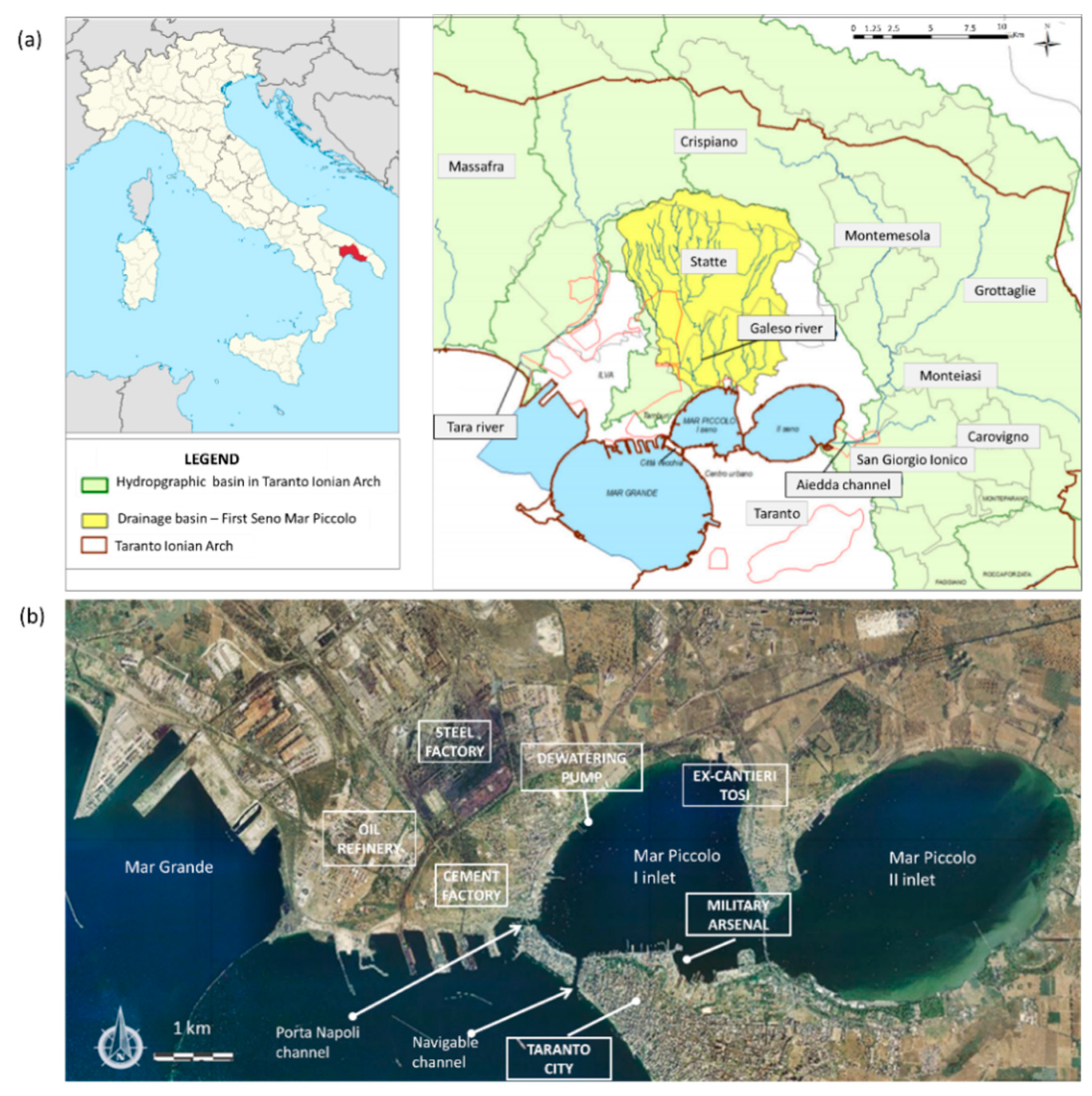
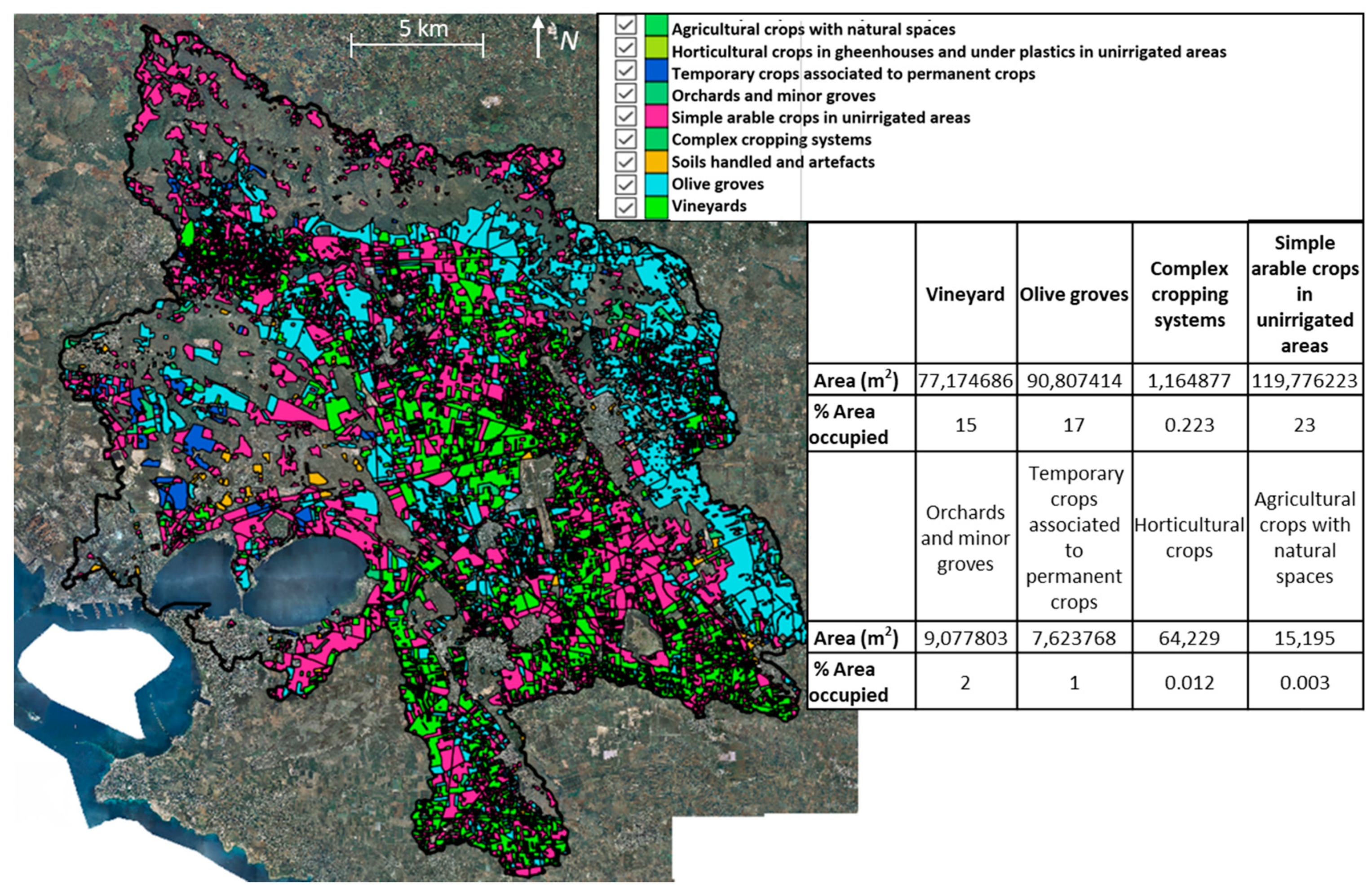


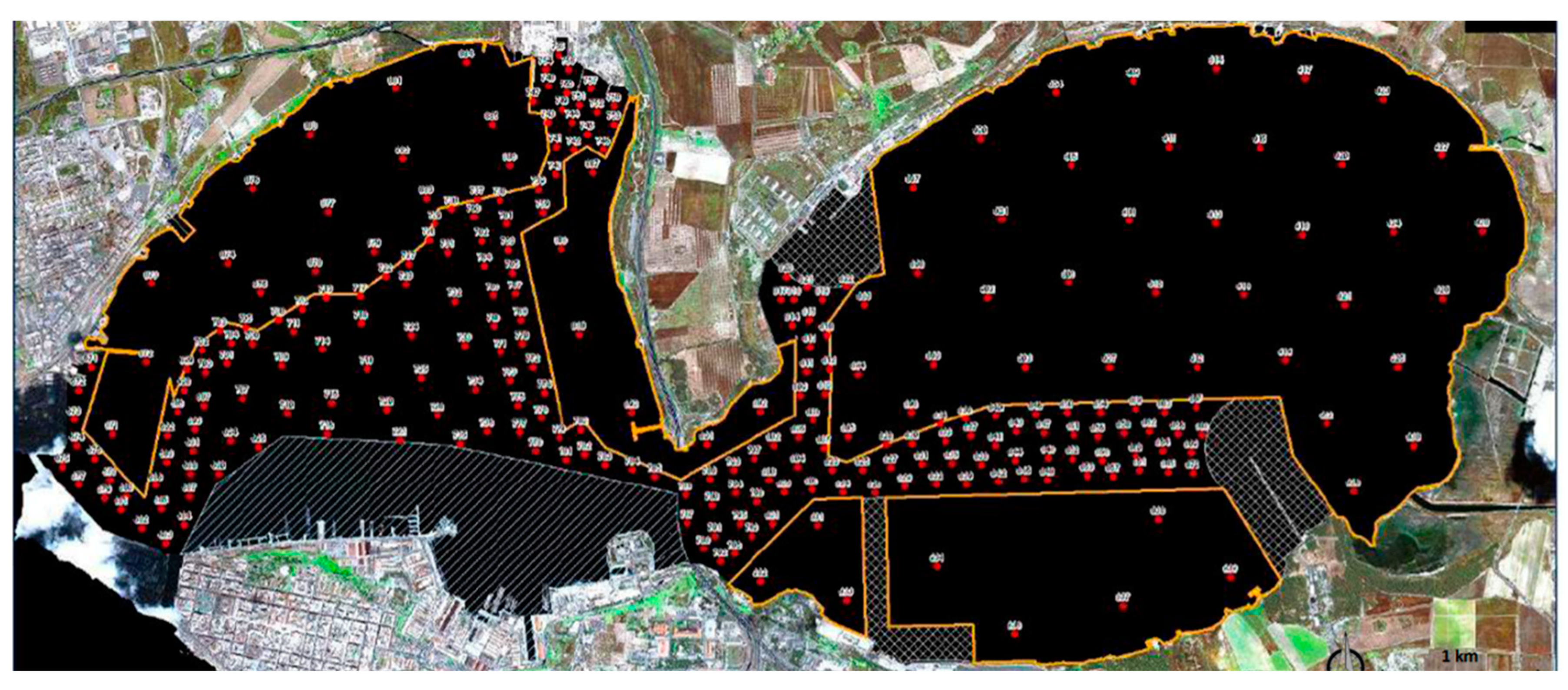


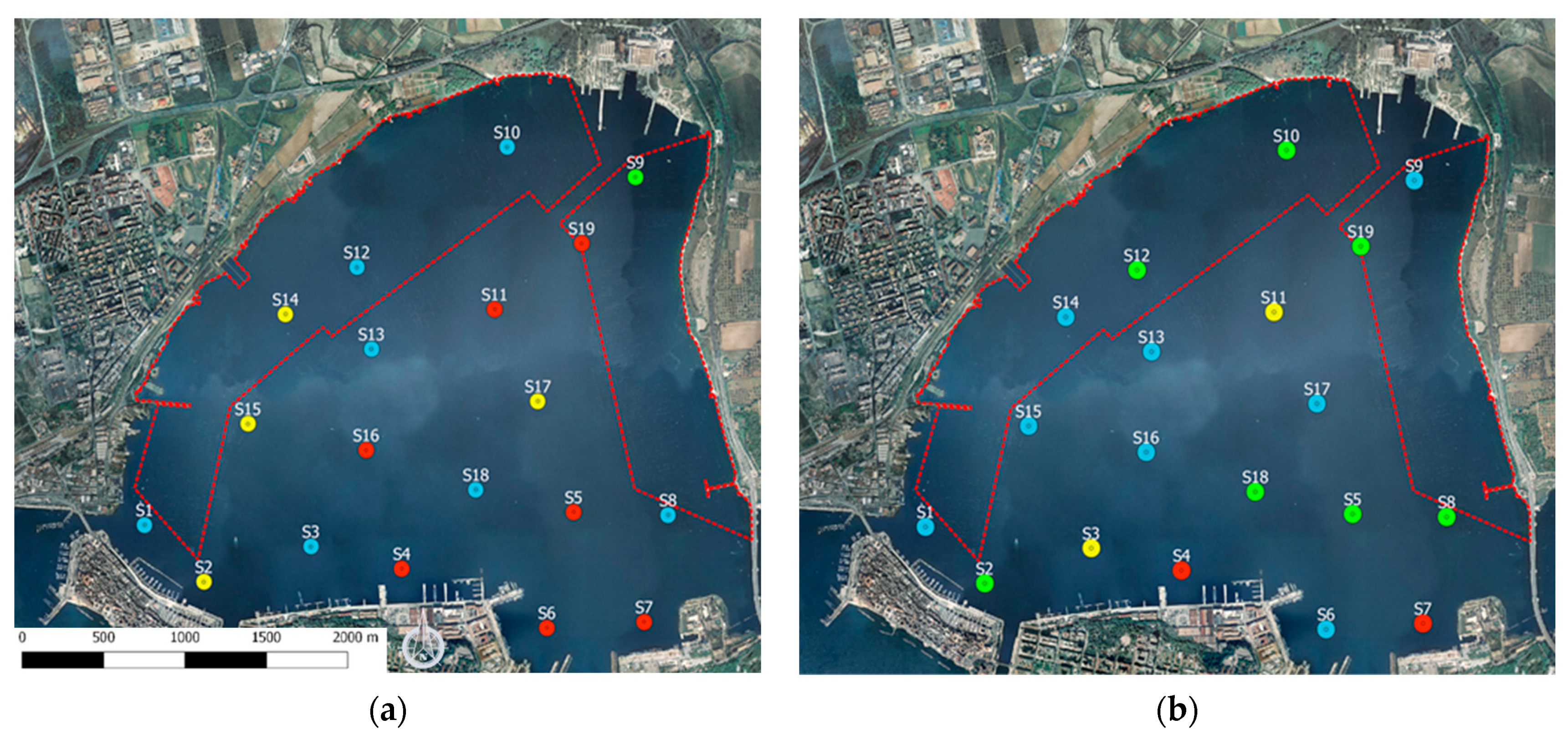



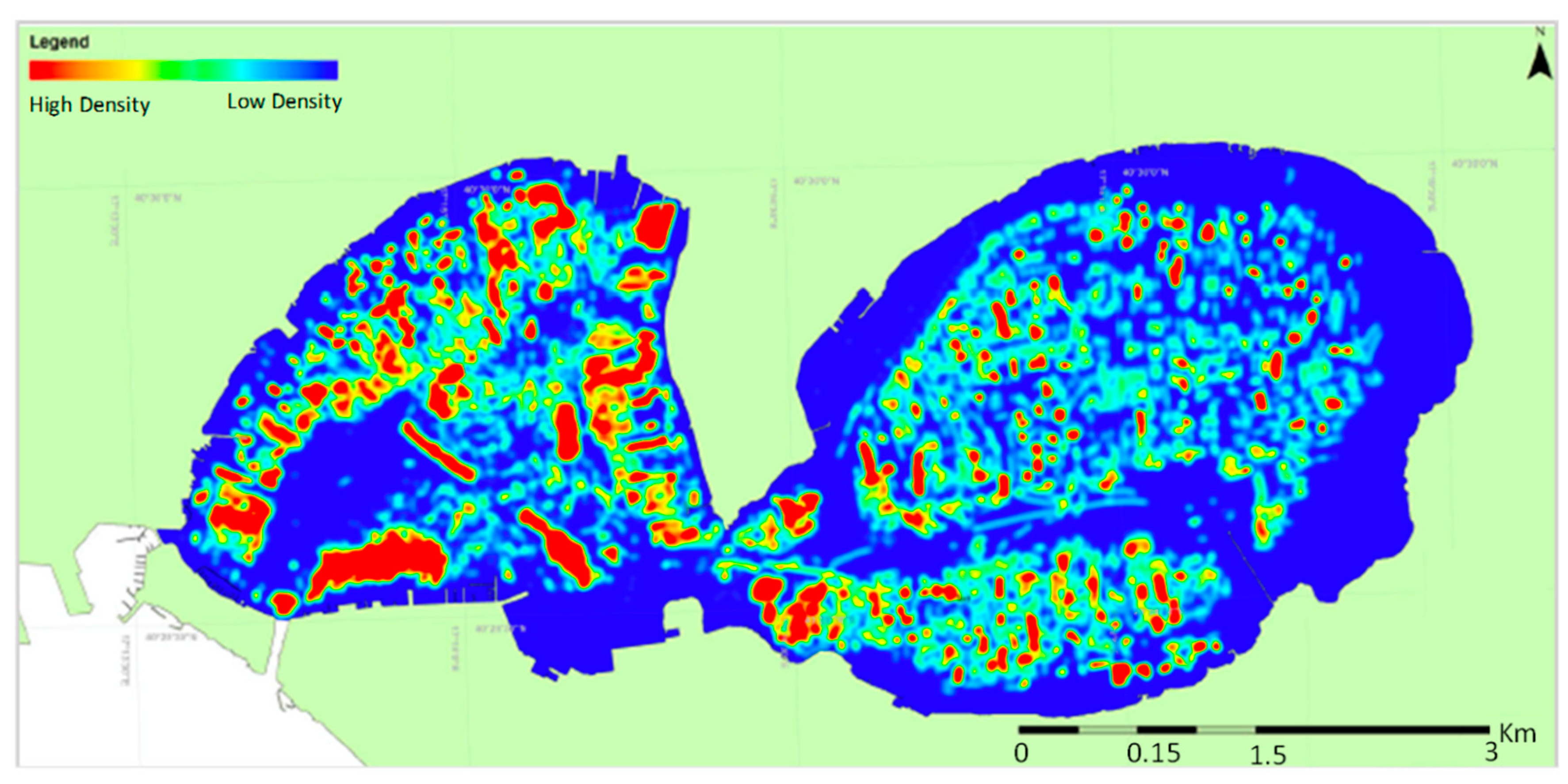

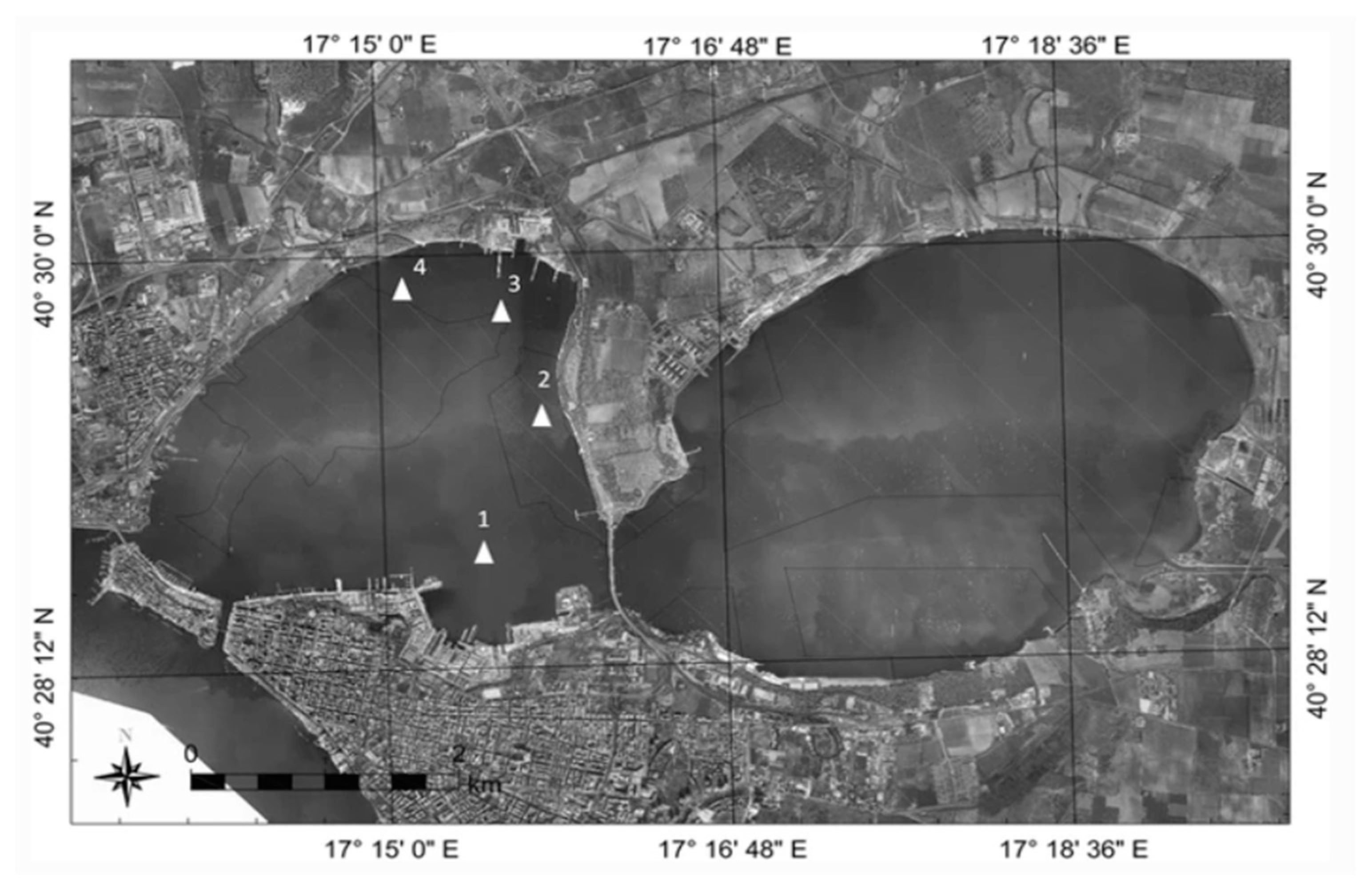
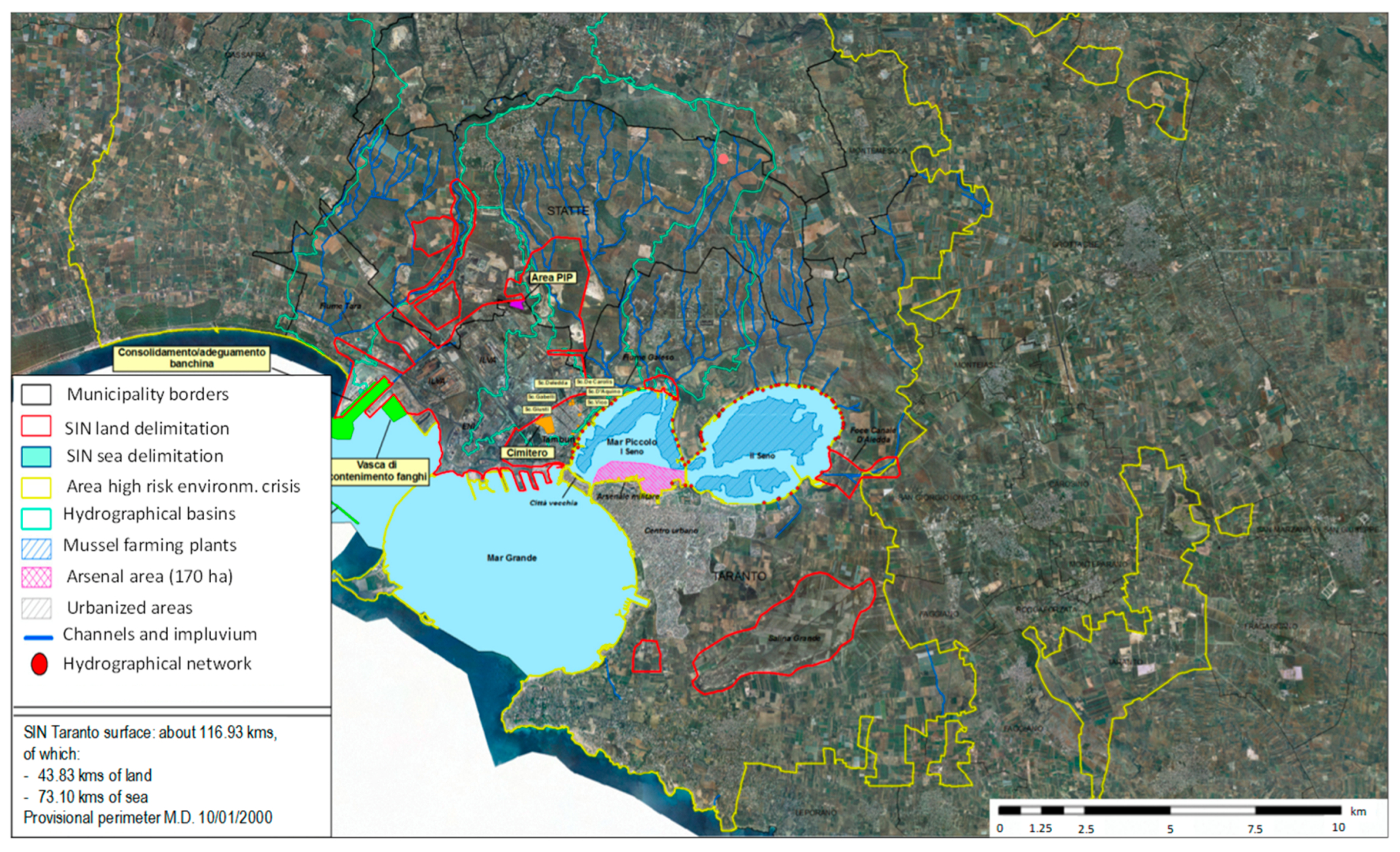
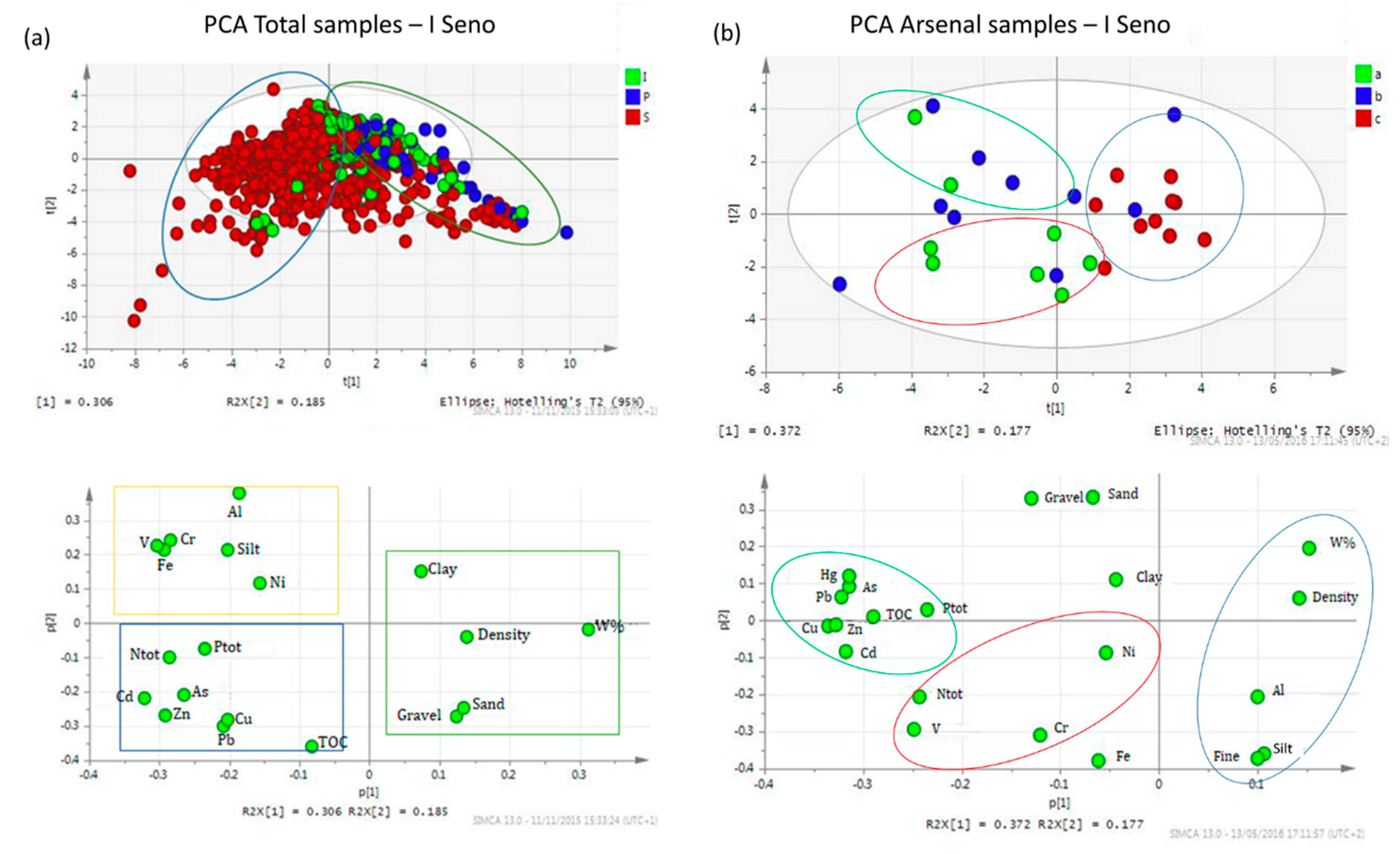
| Litter Typology | Total |
|---|---|
| Car and truck | 90 |
| Parts of car | 34 |
| Motorcycle | 13 |
| Battery | 20 |
| Tire | 234 |
| Bicycle | 5 |
| Wreck with hull | 91 |
| Wreck with motor | 13 |
| Industrial propeller/fan | 3 |
| Drum and large barrel | 14 |
| Medium and small barrel/tin | 25 |
| Fishing net and rope | n.d. |
| Metals | Sediment Station 1 | Metal Fraction <63 µm | Sediment Station 2 | Metal Fraction <63 µm |
|---|---|---|---|---|
| (mg/kg d.w.) | (%) | (mg/kg d.w.) | (%) | |
| As | 34.36 | 35 | 115.30 | 39 |
| Cd | 4.29 | 30 | 1.69 | 28 |
| Cr | 133.41 | 34 | 77.84 | 38 |
| Cu | 177.00 | 38 | 536.00 | 43 |
| Fe | 49,653.00 | 38 | 28,513.00 | 42 |
| Ni | 75.76 | 39 | 54.73 | 45 |
| Zn | 430.00 | 50 | 815.00 | 57 |
| Pb | 121.00 | 64 | 392.00 | 70 |
| Al | 38,672.00 | 33 | 22,803.00 | 38 |
| Mn | 439.00 | 51 | 386.00 | 57 |
| Sn | 15.31 | 13 | 6.86 | 16 |
| V | 134.37 | 31 | 72.84 | 34 |
| Se | 5.92 | 52 | 2.01 | 47 |
| Hg | 5.37 | 64 | 40.61 | 75 |
| Metal | Experiment Typology | T15 | T30 | T45 | Metal | Experiment Typology | T15 | T30 | T45 |
|---|---|---|---|---|---|---|---|---|---|
| As | In situ | 21 | 27 | 47 | Pb | In situ | 160 | 204 | 268 |
| Ex situ | 2 | 19 | 38 | Ex situ | 198 | 260 | 323 | ||
| Cd | In situ | −16 | 26 | 19 | Al | In situ | −4 | 5 | −1 |
| Ex situ | 10 | 26 | 7 | Ex situ | −4 | 6 | 10 | ||
| Cr | In situ | 29 | 146 | 240 | Mn | In situ | 23 | 113 | 204 |
| Ex situ | 1 | 42 | 201 | Ex situ | 5 | 13 | 52 | ||
| Cu | In situ | −19 | 102 | 69 | Sn | In situ | 125 | 175 | 175 |
| Ex situ | −31 | 25 | 36 | Ex situ | 425 | 400 | 525 | ||
| Fe | In situ | 40 | 59 | 62 | V | In situ | 126 | 149 | 187 |
| Ex situ | 18 | 49 | 51 | Ex situ | 9 | 117 | 187 | ||
| Ni | In situ | 12 | 33 | 40 | Se | In situ | 8 | 29 | 19 |
| Ex situ | 81 | 172 | 189 | Ex situ | 10 | −8 | −3 | ||
| Zn | In situ | 23 | 151 | 208 | Hg | In situ | 100 | 550 | 600 |
| Ex situ | 52 | 148 | 268 | Ex situ | 700 | 1250 | 1350 |
| Pollutants | Experiment Typology | T15 | T30 | T45 |
|---|---|---|---|---|
| ∑PCB (ng/g wet weight) | In situ | 31 | 37 | 56 |
| Ex situ | 7 | 14 | 41 | |
| ∑PCBTARGET (28, 52, 101, 153, 138, 180) (ng/g wet weight) | In situ | 26 | 29 | 46 |
| Ex situ | 6 | 10 | 30 |
| Site | Organism | W/D | Cd | Cu | As | Hg | Pb |
|---|---|---|---|---|---|---|---|
| St. 1 | Mytilus galloprovincialis | 5.1 | 0.09 | 1.79 | 3.19 | 0.06 | 0.24 |
| Chlamys glabra | 7.5 | 0.36 | 2.97 | 2.76 | 0.1 | 1.22 | |
| Hexaplex trunculus | 3.4 | 1.67 | 50.95 | 40 | 0.34 | 0.21 | |
| St. 2 | Mytilus galloprovincialis | 5.6 | 0.07 | 1.85 | 2.82 | 0.02 | 0.22 |
| Chlamys glabra | 7.8 | 0.25 | 5.23 | 2.41 | 0.02 | 0.36 | |
| Hexaplex trunculus | 3.8 | 1.49 | 45.59 | 35.8 | 0.3 | 0.19 | |
| St. 3 | Mytilus galloprovincialis | 5.7 | 0.06 | 1.7 | 2.74 | 0.02 | 0.26 |
| Chlamys glabra | 6.1 | 0.28 | 2.11 | 2.61 | 0.02 | 0.43 | |
| Hexaplex trunculus | 3.5 | 1.17 | 17.9 | 17.8 | 0.22 | 0.2 | |
| St. 4 | Mytilus galloprovincialis | 5.7 | 0.09 | 1.96 | 2.8 | 0.02 | 0.27 |
| Chlamys glabra | 7 | 0.3 | 2.56 | 2.59 | 0.02 | 0.59 | |
| Hexaplex trunculus | 3.7 | 1.53 | 35.15 | 34.5 | 0.25 | 0.17 | |
| Boops boops | 4.17 | N.D. | 0.29 | 0.99 | 0.08 | 0.03 | |
| Gobius niger | 4.34 | N.D. | 0.38 | 1.82 | 0.14 | 0.18 | |
| Sarpa salpa | 4.76 | N.D. | 0.17 | 15.9 | 0.09 | 0.21 | |
| Trachurus trachurus | 3.45 | 0.05 | 260.9 | 4.15 | 0.44 | 1.03 | |
| Range | N.D.–1.67 | 0.17–260.92 | 0.99–40.03 | 0.02–0.44 | 0.03–1.22 |
| Site | Organism | W/D | % Fat | 28 | 52 | 101 | 118 | 153 | 138 | 180 | ∑7PCBs | ∑6PCBs |
|---|---|---|---|---|---|---|---|---|---|---|---|---|
| St. 1 | Mytilus galloprovincialis | 5.1 | 1.2 | 0.25 | 0.43 | 10.69 | 10.31 | 30.71 | 17 | 2.45 | 71.84 | 61.53 |
| Chlamys glabra | 7.5 | 0.4 | 0.17 | 2.65 | 2.81 | 7.11 | 31.55 | 13.8 | 11.19 | 69.28 | 62.17 | |
| Hexaplex trunculus | 3.4 | 0.7 | 0.26 | 0.56 | 59.53 | 9.29 | 85.94 | 33.26 | 26.56 | 215.41 | 206.12 | |
| St. 2 | Mytilus galloprovincialis | 5.6 | 1 | 1.41 | 4.36 | 15.98 | 17.46 | 34.68 | 20.77 | 2.02 | 96.68 | 79.21 |
| Chlamys glabra | 7.8 | 0.3 | 0.08 | 0.05 | 1.47 | 3.22 | 15.33 | 3.83 | 3.56 | 27.55 | 24.33 | |
| Hexaplex trunculus | 3.8 | 1.2 | 0.13 | 0.18 | 26.76 | 19.97 | 108.05 | 29.55 | 16.74 | 201.39 | 181.42 | |
| St. 3 | Mytilus galloprovincialis | 5.7 | 0.7 | 1.04 | 7.46 | 24.4 | 27.02 | 62.89 | 37.04 | 5.91 | 165.75 | 138.74 |
| Chlamys glabra | 6.1 | 0.3 | 0.2 | 0.3 | 1.69 | 6.82 | 17.31 | 7.64 | 3.66 | 37.61 | 30.79 | |
| Hexaplex trunculus | 3.5 | 1.7 | 0.31 | 0.29 | 52.6 | 32.46 | 186.66 | 34.8 | 24.2 | 331.31 | 298.86 | |
| St. 4 | Mytilus galloprovincialis | 5.7 | 0.8 | 0.67 | 2.6 | 13.7 | 15.44 | 36.95 | 21.51 | 2.16 | 93.02 | 77.58 |
| Chlamys glabra | 7 | 0.6 | 0.3 | 0.17 | 2.69 | 2.24 | 13.37 | 3.4 | 0.43 | 22.6 | 20.36 | |
| Hexaplex trunculus | 3.7 | 1.5 | 0.35 | 5.81 | 35.22 | 32.59 | 172.05 | 45.92 | 45.27 | 337.22 | 304.62 | |
| Boops boops | 4.2 | 0.6 | N.D. | 0.12 | 3 | 1.78 | 105.6 | 30.13 | 29.4 | 170.03 | 168.25 | |
| Gobius niger | 4.3 | 0.4 | 0.31 | 0.58 | 3.1 | 4.91 | 37.39 | 22.29 | 15.23 | 83.81 | 78.9 | |
| Sarpa salpa | 4.8 | 1.1 | N.D. | 0.08 | 2.34 | 2.31 | 23.22 | 10.97 | 7.4 | 46.32 | 44.01 | |
| Trachurus trachurus | 3.5 | 4.3 | 0.1 | 3.67 | 29.62 | 14.7 | 174.54 | 92.77 | 41.89 | 357.26 | 342.55 | |
| Range | N.D.–1.41 | 0.05–7.46 | 1.47–59.53 | 1.78–32.59 | 13.37–186.66 | 3.40–92.77 | 0.43–76.75 | 22.60–357.26 | 20.36–342.55 |
| Site and Reference | Environmental Matrices | Total PAHs | Total PCBs | Metals | |
|---|---|---|---|---|---|
| Mecoacàn Lake Estuarine, Mexico [100] | water | 0.3–2.8 µg/L | - | - | |
| sediments | 0.1–36 mg/kg | 0.1–59 µg/kg | Cu (0.1 mg/kg), Zn (12 mg/kg) | ||
| Venice lagoon, Italy [101] | water | 19.6–178.9 ng/L | 1.2–10.5 ng/L | - | |
| Naples harbor, Italy [102] | sediments | 9–31,774 ng/g | 1–899 ng/g | As (1–1121 mg/kg), Cd (0.01–3 mg/kg), Co (1–30 mg/kg), Cr (7–1798 mg/kg), Cu (12–5743 mg/kg), Pb (19–3083 mg/kg), Ni (4–362 mg/kg), Hg (0.01–139 mg/kg), V (37–2114 mg/kg) and Zn (17–7234 mg/kg). | |
| Guánica Bay, Puerto Rico [103] | sediments | 9.637–4663.143 ng/g | 0.11–3059.9 ng/g | As (1.28–12.80 mg/kg), Cd (0–0.11 mg/kg), Cr (3.48–1930 mg/kg), Cu (0.89–102 mg/kg), Hg (0–0.19 mg/kg), Ni (4.88–709 mg/kg), Pb (0.20–31.90 mg/kg) and Zn (2.21–153 mg/kg). | |
| Lake Chaohu, China [104] | sediments | - | 672 ± 1293 pg/g | Cd (0.966 ± 0.481 mg/kg), Cu (30.9 mg/kg), Hg (0.570 ± 0.510 mg/kg), and Zn (122.5 ± 53.2 mg/kg). | |
| Our study Mar Piccolo of Taranto, Italy | [31] | water | >0.2 pg/L | 4652 pg/L | Cd (>0.3 μg/L), Cr (>0.3 μg/L) and Pb (>7.2 μg/L). |
| [46] | sediments | 56–36,370 μg/kg | 20–9391 μg/kg | As (3.77–48 mg/kg), Cd, (0–1.5 mg/kg), Cu (9.1–172.7 mg/kg), Hg (0–16.7 mg/kg), Ni (23.33–60.66 mg/kg), Pb (24.42–272.54 mg/kg), V (25.67–95.61 mg/kg), Zn (38.51–602.89 mg/kg). | |
| Site and Reference | Driving Forces | Pressures | States | Impacts | Responses |
|---|---|---|---|---|---|
| Sarno river, Italy [11] | - Demography - Agricultural land use - Industrial development | - Water consumption and wastewater - Waste production - Air pollution | - Genotoxic effects - Contamination of matrices - High concentration nutrients - Presence of illicit drugs | - Risk to trophic chain, horticultural products, and animal fed | - Water and wastewater management - Waste management - Air pollution prevention |
| Asian cities (Bangkok, Jakarta, Manila, Osaka, Seoul, Taipei, and Tokyo) [15] | - Population growth - Industrialization | - Wastewater discharge - Oil leakage - leachate from landfills - Water demand - Groundwater use - Land use change | - Chemical contamination - Microbial contamination - Salinity - Decrease GW levels - Decrease GW recharge | - Human health risks - Impacts on organisms - Land subsidence - Flooding - Damage to infrastructure | - Change in consumption and production - Improve sanitation and waste disposal - Alternative source of water - Improve water quality - Control pumping areas - Flood control |
| Choghakhor wetland, Iran [105] | - Agricultural activities - Water requirement of lowland - Tourism - Settlements and urban areas - Mining activities in upland - Population Growth - Drought | - Construction of deep and semi-deep wells -Drainage of the agricultural wastewater containing pesticides and fertilizers -Uncontrolled development of fields, gardens and water harvesting - Water transfer with channel by the edge of wetland - Excavation and construction of the channel in margin of wetland - Increased tourists despite lack of facilities - Sprawl growth and dacha building without infrastructure and sanitary sewage disposal - Land use change and eliminating the vegetation - Sewage and waste production - Mining and creating dust and aerosols - Excessive harvesting of wetland biological resources - Illegal fishing and hunting | - Drying the springs - Declining groundwater table - Increasing in organic and inorganic contaminants (Eutrophication) - Decreasing the quality water and dissolved oxygen - Increased sediment load - Loss of the surrounding wetland habitats - Increasing waste and reducing habitat quality - Leakage and infiltration of wastewater into groundwater and contamination despite high density springs - Groundwater and surface water contamination - Habitat loss and increase flooding potential - Reducing the quality and quantity of habitat - Accumulation of pollution disturbs the stability of the hydrological regimes | - Disturbance in hydrological Regimes - Decreasing the biochemical products - Reducing the water regulation - Biodiversity loss and reduction in habitats - Reducing primary and biomass production - Reducing the educational opportunities | - A comprehensive environmental assessment of water transition system - Developing master plans for tourists with environmental and potential of landscape consideration - Reduction in usage of pesticides and fertilizers and conscious of their correct application, decrease the unhealthy consequences - Development of continuity plans and wildlife nurture and give authorization in hunting to restrict illegal hunting - Mitigate drought impacts and apply solutions, such as optimized selection of land use, selection of improved variety of crops, change in the tillage technology, land restoration, and proper irrigation - Focus on impacts of water development plans and programs |
| Jiangsu province, China [106] | - Total food crops output - Population density - Urban built-up area - Industrial sector | - Disproportion of arable land area in total land area - Total power of agricultural machinery per unit sown area - Chemical fertilizer use - Pesticide use - Irrigation - Acid rain | - Scarcity of wild higher plants - Scarcity of wild higher animals - Disproportion of woodland, garden and grassland area in total | - Farming output value per chemical fertilizer use - Food crops output per unit sown area - Tourism income - Housing area per capita in rural area - Proportion of rural population with new cooperative medical insurance | - Government agricultural expenditure per unit sown area of crops - Agricultural loans per unit sown area of crops - Number of agricultural science and technology personnel - Years of rural education |
| Mar Piccolo of Taranto, Italy [Our study] | - Demography - Agriculture - Industry - Landfills and treatment plants | - Discharges of nutrients and contaminants - Pollution in groundwater - Air pollution | - Marine sediment characterization - Sea water characterization - Biodiversity - Anthropization of sea bottom - Marine litter | - Contaminant mobility - Effects of contaminants in marine organisms - Human health - Eutrophication of toxic algae - Dewatering pump | - Political approach - Remediation technologies |
© 2020 by the authors. Licensee MDPI, Basel, Switzerland. This article is an open access article distributed under the terms and conditions of the Creative Commons Attribution (CC BY) license (http://creativecommons.org/licenses/by/4.0/).
Share and Cite
Labianca, C.; De Gisi, S.; Todaro, F.; Notarnicola, M. DPSIR Model Applied to the Remediation of Contaminated Sites. A Case Study: Mar Piccolo of Taranto. Appl. Sci. 2020, 10, 5080. https://doi.org/10.3390/app10155080
Labianca C, De Gisi S, Todaro F, Notarnicola M. DPSIR Model Applied to the Remediation of Contaminated Sites. A Case Study: Mar Piccolo of Taranto. Applied Sciences. 2020; 10(15):5080. https://doi.org/10.3390/app10155080
Chicago/Turabian StyleLabianca, Claudia, Sabino De Gisi, Francesco Todaro, and Michele Notarnicola. 2020. "DPSIR Model Applied to the Remediation of Contaminated Sites. A Case Study: Mar Piccolo of Taranto" Applied Sciences 10, no. 15: 5080. https://doi.org/10.3390/app10155080
APA StyleLabianca, C., De Gisi, S., Todaro, F., & Notarnicola, M. (2020). DPSIR Model Applied to the Remediation of Contaminated Sites. A Case Study: Mar Piccolo of Taranto. Applied Sciences, 10(15), 5080. https://doi.org/10.3390/app10155080








